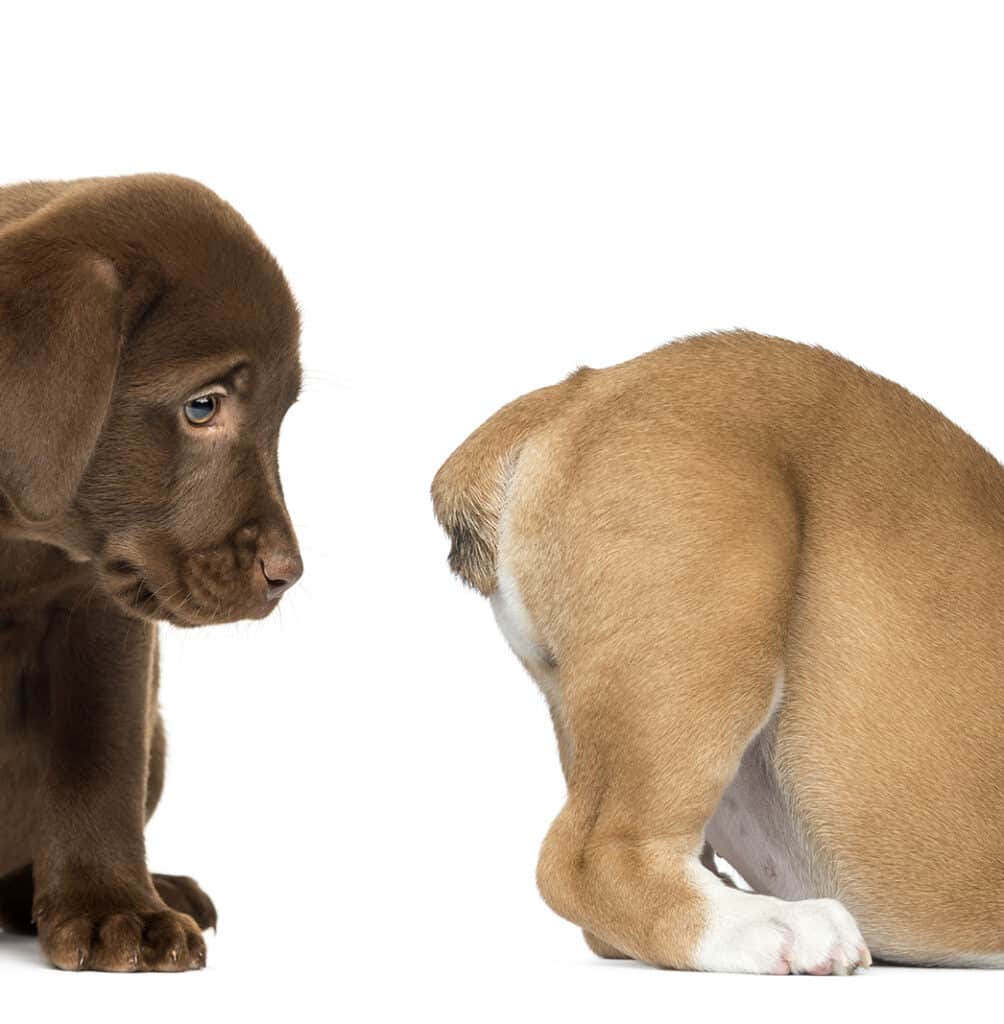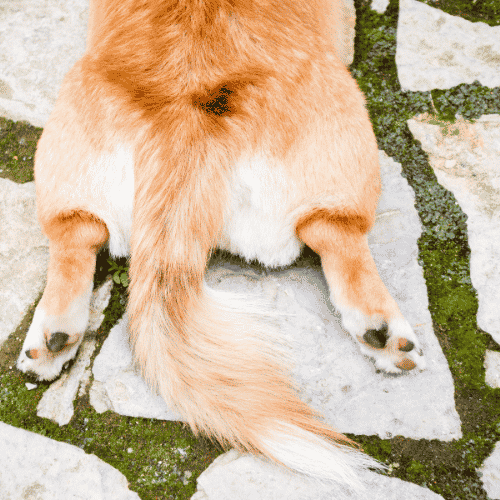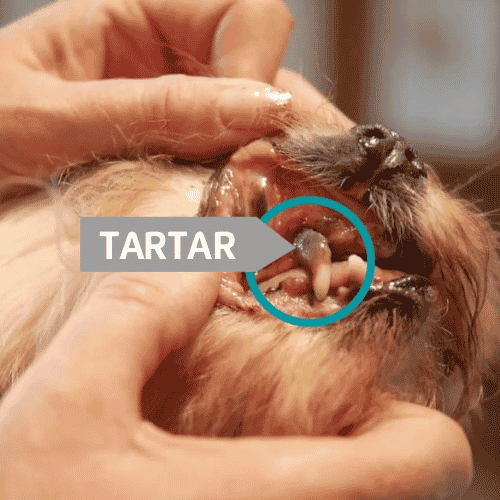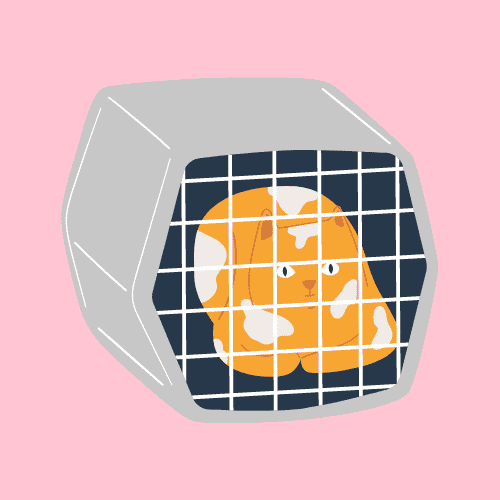Hair loss is something that almost all dog owners have experienced in their pets. But why does it happen? Why does a dog lose hair around the bum?
Loss of hair around the bum can be a normal occurrence, or it can result from itching or scratching (self-inflicted hair loss, such as that caused by sarcoptic mange, fleas, or allergies) occasionally due to ringworm or hypothyroidism.
It takes some time for you or your vet to rule out the exact cause of hair falling around a dog’s bum. So, please take a deep breath and attempt to figure out why it is happening.

If your dog is constantly scratching that region and attempts to lick or chew it, this indicates that the reason is infectious. In other words, it might be a parasite or bacterial infection on your dog’s skin. There are a variety of infections, including bacterial, fungal, and yeast infections, that can cause your dog to lose hair on her back/bum. If something like this happens, you should consult your veterinarian as soon as possible. Many things might irritate dogs and cause them to lose their hair.
Let us discuss the reasons for dogs losing hair around the bum in detail.
Hmong Dog: A Comprehensive Guide to Caring for Your Hmong Dog
Reasons for Hair Loss Around Dog’s Bum
The area of a dog’s body close to its tail may experience hair loss for various causes. Here are some significant ones.

- Infections
Because of bacterial or fungal yeast infections, your dog may have hair loss, itching, and redness on his or her body around the bum. If you see any irritation on your dog’s skin, you should make an appointment with a veterinarian as soon as possible.
- Allergic Bald Spot
One of the most common reasons dogs experience bald patches and overall hair loss is due to allergies. The most frequent symptoms are itchy skin, inflammation, hair loss, and patches of baldness. Most allergic reactions are hereditary and are acquired from one’s parents. Dogs are susceptible to various allergies, including environmental allergies and dietary allergies.
Seasonal allergies are another type that might affect your dog, but they will only manifest themselves during particular year periods.
- Ringworm
A kind of fungus known as ringworms is responsible for the loss of hair and the formation of circular, bald patches. Infection with ringworm can be complicated to treat in young puppies. Ringworm may be treated with many different anti-fungal medications.
- Fleas and Ticks
Your dog’s skin may get irritated, develop bald spots, and suffer from various other issues due to fleas and ticks. Fleas and ticks thrive in dogs’ fur because it is an ideal habitat for them, and dogs may take up fleas quite quickly while they are outside.
- Demodectic Mange
Your dog may be suffering from mange’s skin condition caused by microscopic parasites called mites. It’s common for these mites to burrow deep inside your dog’s hair follicles. Dogs suffering from demodectic mange will have hair loss, scabbing, and ulcers. Mites have the potential to rapidly spread and even deposit eggs deep into the skin of your dog. As a result, it is of utmost importance that you cure them as soon as possible.
- Poor Nutrition
It’s also possible that your dog’s hair loss and bald patches result from a nutritional deficiency. The food that you provide your dog should be well-balanced to avoid the dog developing nutritional deficits.
What Happens if My Dog Loses Hair Without Itching?
If your dog’s hair loss is not due to normal shedding and he or she is not itching, the following may be the cause:
- Hypothyroidism: Because the thyroid gland controls your dog’s metabolic rate, the first symptom that some owners notice is a steady increase in their dog’s weight. The hair is dry and brittle. It readily breaks off in a uniform pattern because there may be additional symptoms, such as hostility; the dog should visit his veterinarian and take an immediate blood test to identify and treat the condition.
- Hyperadrenocorticism: Also known as Cushing’s disease, is a condition that is produced by an excess of steroids in the body. Although there are numerous clinical symptoms associated with this condition, the changes in the skin are often the most noticeable. The skin turns darker, the dogs lose hair all over their bodies, the dogs may have blackheads on their bellies, and the dogs’ bellies get swollen and large. Some owners will discover that their dogs are extremely dehydrated and, as a result, will require more frequent trips outside. The dog must be examined and diagnosed by a veterinarian to begin therapy for these conditions as hypothyroidism.
- Other hormonal problems (Estrogen excess, estrogen deficiency, and growth hormone-responsive alopecia). If a tumor in your dog’s body is producing an excess of estrogen, you may notice that his or her skin and coat begin to darken around the bum, and the hair will eventually become brittle and fall off. Hormonal problems can only be identified by blood testing, so take the dog to your veterinarian.
- Autoimmune diseases: Although these diseases can cause hair loss, it is usually not as severe as the skin ulcers and subsequent infections that they can cause.
Three Best Treatments for Hair Losing Dogs
Your dog’s hair loss therapy may differ based on the condition’s underlying cause. But in most cases, it will consist of a few essential treatments that you can also give your dog to assist them in managing their disease.
- Nutrition
The first thing you should do to ensure that your dog has a healthy coat is to check that they are getting all the vitamins and minerals they require.
Dogs that take a poor diet will undoubtedly exhibit physical signs, and the most prevalent is hair loss. This is because their bodies will allocate all of their energies to the critical organs and ignore the coat in favor of supporting the organs.
Your dog must consume food rich in protein and the vitamins and minerals that it needs to maintain its size and strength.
- Controlling Allergens
Regarding allergies, if you want to prevent your dog from losing its hair, you should make sure that your dog is not exposed to any of the allergens that are now known to exist.
In some cases, allergy control can be as easy as a few basic steps, such as avoiding giving a certain meal to your dog. On other occasions, however, allergen control can be more challenging.
- Shampoo
Itching and irritation are often experienced together. Itchiness is a common symptom of irritated skin, and scratching the itch can make the irritation even more severe.
The itching sensation may be eliminated by using shampoos and sprays that have been specially created to treat this issue. These products calm the skin, causing it to become less inflamed and decreasing the desire for the skin to be scratched.

Doctor of Veterinary Medicine (D.V.M.) at Nation Taiwan University,Master of Science (M.S.) in Biomedical Engineering at National Taiwan University of Science and Technology




